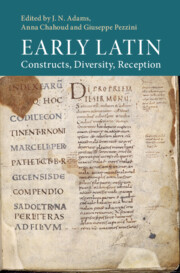Book contents
- Early Latin
- Early Latin
- Copyright page
- Dedication
- Contents
- Illustrations
- Tables
- Contributors
- Acknowledgements
- Abbreviations
- Chapter 1 Introduction: What Is ‘Early Latin’?
- Part I The Epigraphic Material
- Part II Drama
- Part III Other Genres and Fragmentary Authors
- Part IV Reception
- Chapter 20 ‘Early Latin’ and the Fragments of Atellane Comedy
- Chapter 21 Lucretius and ‘Early Latin’
- Chapter 22 Cicero and Early Dramatic Latin
- Chapter 23 Early Latin Texts in Livy
- Chapter 24 Pliny Rewrites Cato
- Chapter 25 Gellius’ Appreciation and Understanding of ‘Early Latin’
- Chapter 26 Views on ‘Early Latin’ in Grammatical Texts
- Chapter 27 Nonius Marcellus and the Shape of ‘Early Latin’
- Chapter 28 ‘Early Latin’ to Neo-Latin
- Chapter 29 Conclusions
- Bibliography
- Index Verborum
- Index of Non-Latin Words
- Index Locorum Potiorum
- Subject Index
Chapter 26 - Views on ‘Early Latin’ in Grammatical Texts
from Part IV - Reception
Published online by Cambridge University Press: 27 July 2023
- Early Latin
- Early Latin
- Copyright page
- Dedication
- Contents
- Illustrations
- Tables
- Contributors
- Acknowledgements
- Abbreviations
- Chapter 1 Introduction: What Is ‘Early Latin’?
- Part I The Epigraphic Material
- Part II Drama
- Part III Other Genres and Fragmentary Authors
- Part IV Reception
- Chapter 20 ‘Early Latin’ and the Fragments of Atellane Comedy
- Chapter 21 Lucretius and ‘Early Latin’
- Chapter 22 Cicero and Early Dramatic Latin
- Chapter 23 Early Latin Texts in Livy
- Chapter 24 Pliny Rewrites Cato
- Chapter 25 Gellius’ Appreciation and Understanding of ‘Early Latin’
- Chapter 26 Views on ‘Early Latin’ in Grammatical Texts
- Chapter 27 Nonius Marcellus and the Shape of ‘Early Latin’
- Chapter 28 ‘Early Latin’ to Neo-Latin
- Chapter 29 Conclusions
- Bibliography
- Index Verborum
- Index of Non-Latin Words
- Index Locorum Potiorum
- Subject Index
Summary
The interest in early Latin developed mainly outside the field of normative grammar, particularly in authors who belonged to the tradition of scholarly or antiquarian writing. Varro’s encyclopaedic works testify to a unique effort to save uestigia of the cultural and historical past by means of linguistic operations. His approach soon lost its institutional character and was replaced by curiosity for rare minutiae, as in Pliny’s Dubius Sermo. Grammarians like Probus and Caper, whose orientation was philological rather than didactic, considered that the auctoritas of literary models made divergences from the norm or contemporary usage acceptable, and viewed uetustas as the area of experimental variation, both lexical and morphological, with respect to the usage of Republican writers. The inclusion of an immense corpus of literary quotations in comprehensive works (artes grammaticae) facilitated the adoption of an overall perspective that embraced the evolution of the linguistic system at all levels, and kept alive an awareness of the diachronic dimension of the language, which became increasingly profound in scholars like Priscian who read Terence in sixth-century Constantinople.
Keywords
- Type
- Chapter
- Information
- Early LatinConstructs, Diversity, Reception, pp. 527 - 548Publisher: Cambridge University PressPrint publication year: 2023
- 1
- Cited by

